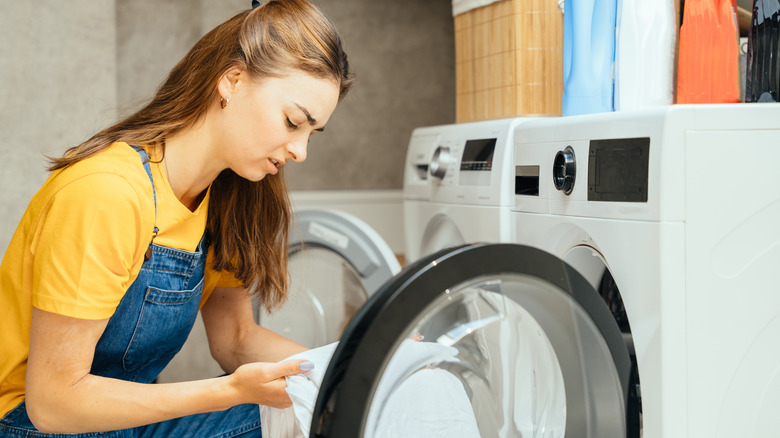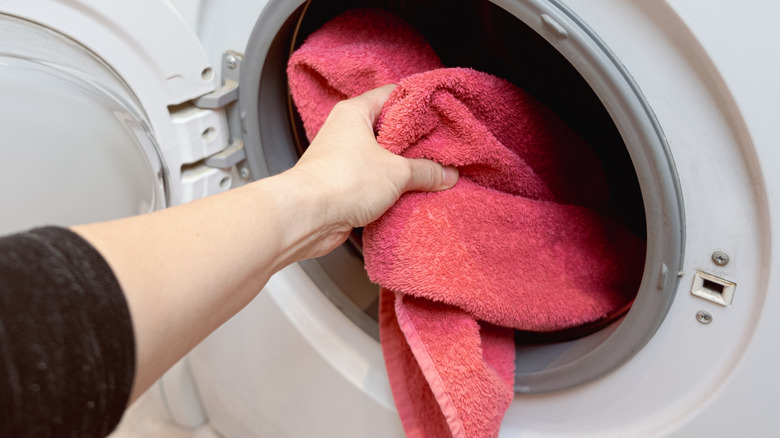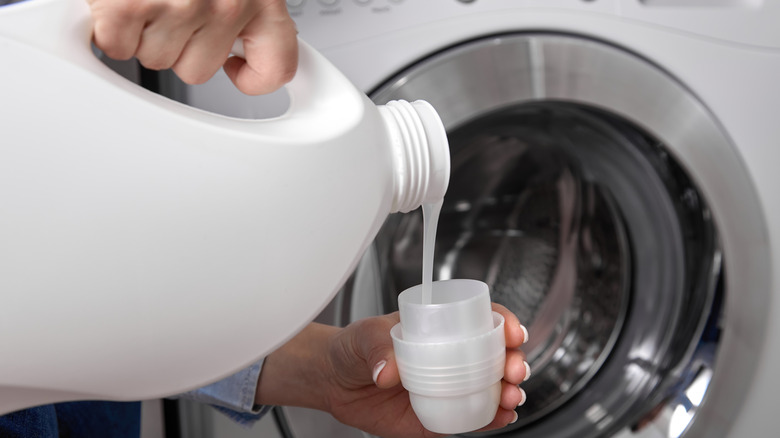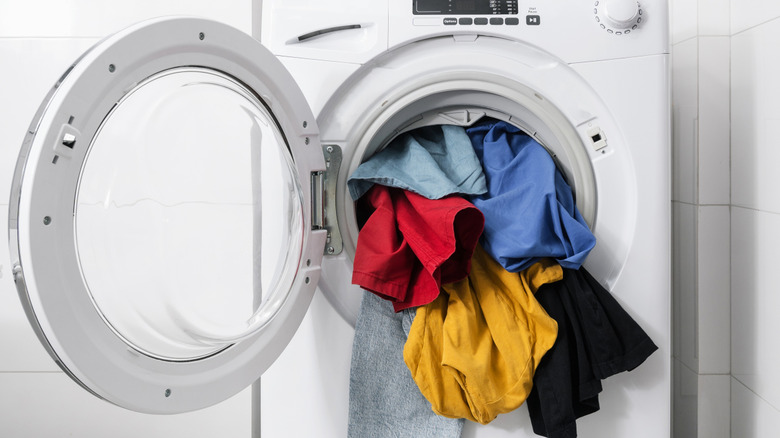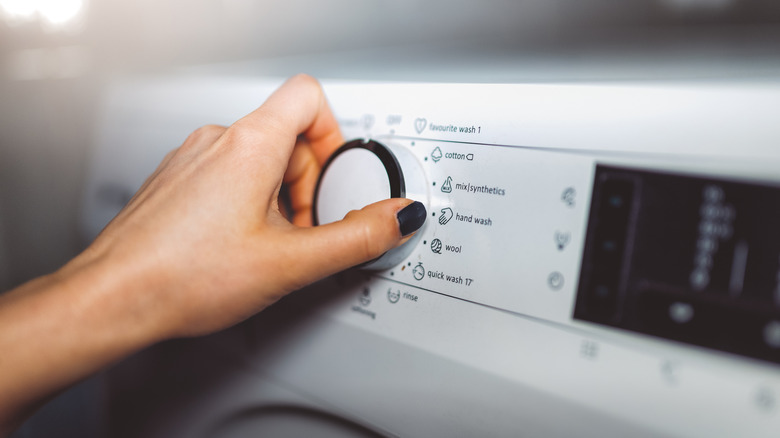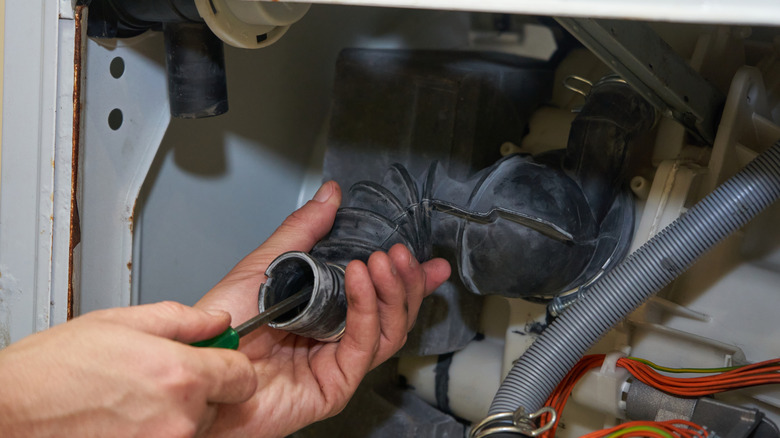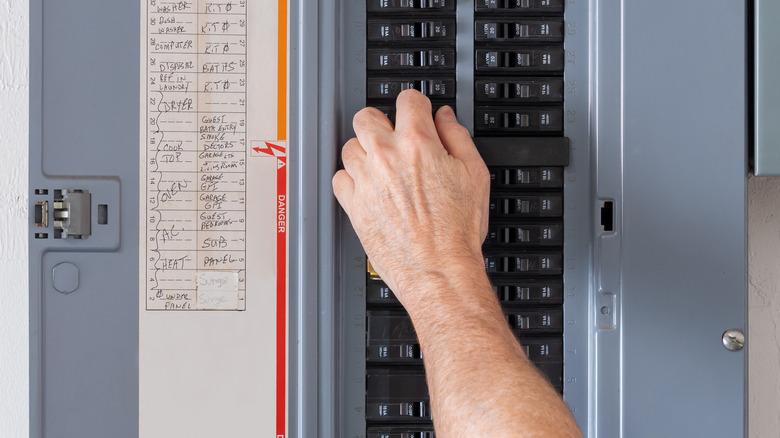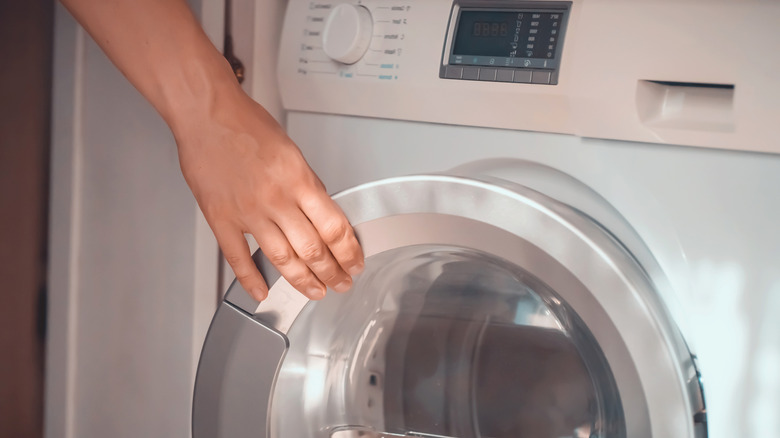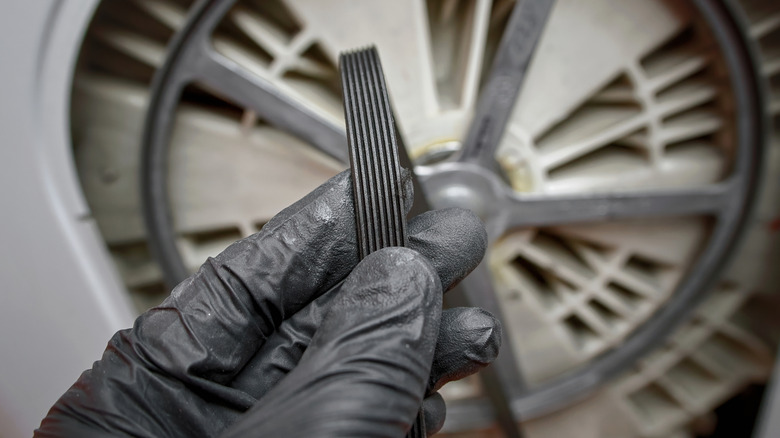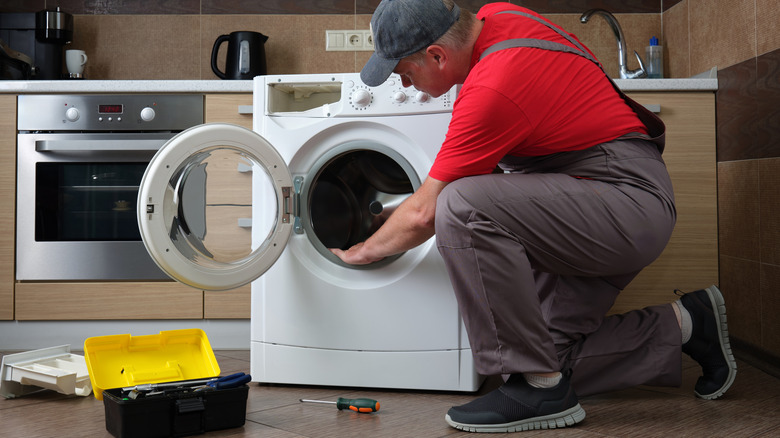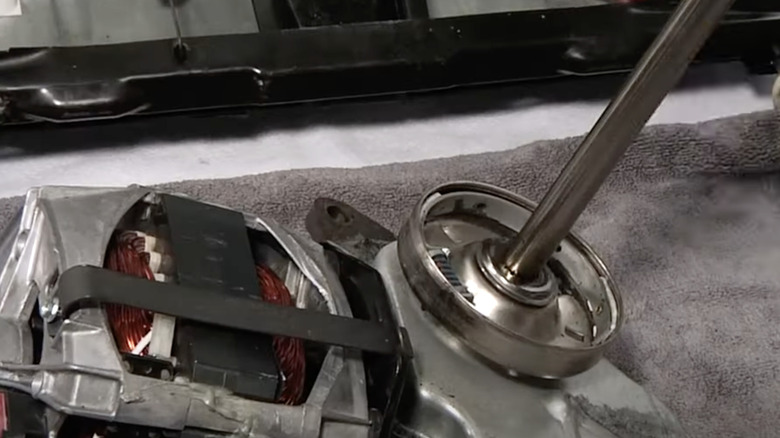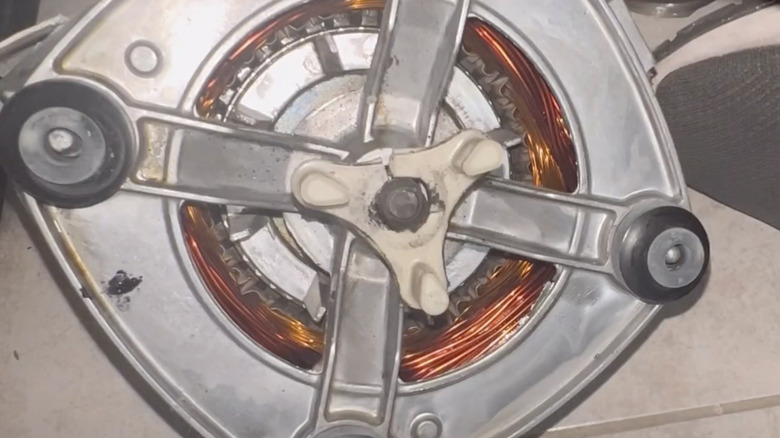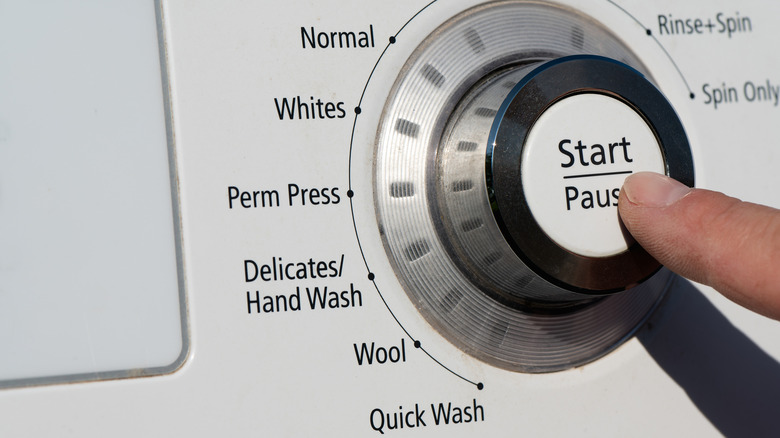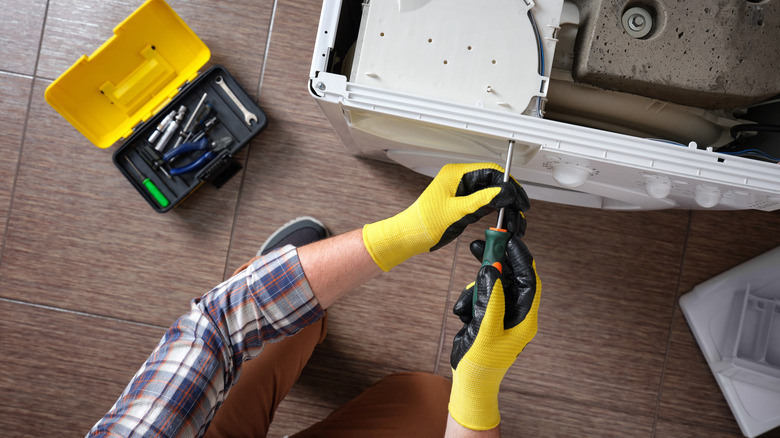14 Reasons Your Washing Machine Isn't Spinning (And How To Fix It)
Going to throw your clothes in the dryer and discovering that your washer hasn't spun the water out of your laundry can be extremely aggravating. Not only are you stuck with sopping wet clothes, but now you need to find the reason your washing machine isn't working. Many different mechanisms work together to make your washer spin and wring out your fabrics, and you'll need to inspect your machine to determine what part is causing the problem. Alternatively, you might be unwittingly putting unnecessary stress on the machine that's keeping it from spinning as fast as it should — or at all.
While some causes of your washer not spinning are super simple to fix and can be done quickly by yourself, others may require part replacements. In some cases, you may need to hire a professional to service your washer to get it spinning again. To keep your washer working at peak performance, be sure to check the manual to know what size load your machine is capable of handling and what kind of detergent to use. If you notice your washing machine shaking, making weird noises, or leaving your clothes wetter than normal, it's a sign the appliance isn't spinning properly. Here are some common reasons for washing machines not spinning and what you can do about them.
Bulky pieces of laundry can imbalance the load and affect your washer's spin
If you're wondering why your washing machine is shaking like crazy, it may be because you have an imbalanced load of laundry. When you're washing larger or bulky items like sheets, blankets, and towels, it's crucial to arrange them in the machine so that the weight is fairly even around the drum. Otherwise, the fabrics will unbalance the washer, cause it to have a wobbly spin, make clunking noises, and shake. While these bulky pieces of laundry can ball up on their own and unbalance the washer during the cycle, adding only one towel or sheet to a load may also create an imbalanced load. When the drum shakes too much, the washer will stop the spin cycle.
Over time, continually unbalancing the washer adds stress to the machine and can cause damage. If you have just one big item to wash, try putting some pieces of clothing or dish towels in with it to add weight to the rest of the drum. Pausing the washer if you hear it become imbalanced and redistributing the laundry evenly will help it spin again.
Using excess laundry detergent makes it difficult for your washer to drain and spin
Although some people think using more detergent is better, it could be the surprising reason your washer isn't spinning correctly. When you add too much soap to your laundry, it produces an overabundance of bubbles and suds that your washer isn't prepared to handle. Too many suds will prevent your washing machine from draining or spinning properly, leaving you with wet, soapy clothes.
Unfortunately, using the incorrect type of detergent for your washer can also prevent it from spinning. Besides using the right type, it's crucial to make a note of how much to use for various-sized loads. If your clothes are already soapy and wet, try running another rinse cycle to wash away the detergent. By using the right kind and amount of laundry soap, you can keep your washer running and spinning like it should.
Stuffing too many clothes in your washing machine can make it unstable
One of the dangers of overloading your washing machine is that it prevents it from spinning correctly and wringing out your clothes. When there are too many clothes stuffed into the drum, your washer won't be able to spin as fast, and in some cases, it may stop spinning altogether. The weight of all this laundry can unbalance your washing machine, causing it to stop itself from spinning.
If your washer does continue spinning, it could be very slow and delay the cycle. If it becomes imbalanced and stops itself, you'll need to take some of the laundry out of the washer or rearrange it to be more evenly spread throughout the drum. Taking care not to put too many items in your washing machine at once will help keep it spinning fast and wringing all the water out of your clothes.
Washing machines that aren't level may become unbalanced
A washer that is making a ton of noise, shaking, or moving around during the cycle is likely not level. When your washing machine doesn't sit evenly on the floor, it's more likely to unbalance itself and have trouble spinning; you could even be destroying your washer without even noticing. Besides damaging the appliance, its rough movements may even scratch your floor.
If your washer isn't spinning correctly and is thumping around with each cycle, it's time to pull out a bubble level and ensure your machine is sitting flat on the floor. Check to see which of the washer's legs are uneven, propping up the machine with a piece of wood if needed. Twist the lock nuts on the legs to move them up or down until your washer is level. When attempting to lift or move your washing machine, it's important to have another person's help, as these appliances are extremely heavy.
If your washer won't spin enough, you may have accidentally set it to delicate
When you're rushing around your house trying to get all the chores done, it can be easy to accidentally click the wrong button while starting your laundry. While gentle and delicate cycles are fantastic for fabrics that shouldn't be stretched much, using them with a regular load of laundry will likely leave your clothes dripping wet. These cycles have a very slow spin setting, or sometimes no spin at all. If you accidentally use this setting for a heavier load, your washer won't be able to wick away as much moisture.
After discovering soaked clothing or even a little water in the washer's drum, you'll need to run another cycle to get rid of some of the water. Leave the wet laundry inside your machine and set it to a drain-and-spin cycle to get it spinning fast enough. Otherwise, try using faster cycles to wash your clothes if they are appropriate for the fabric.
Your washing machine won't be able to spin with a clogged drain hose
Even a little bit of debris can clog a washer's drain hose, making it a common problem for this appliance. When water cannot flow out of your washer properly through the drain hose, the fluid comes back into the drum, preventing the machine from spinning. Sometimes, clogs will make your washer drain very slowly or not at all. Your drain hose may also have a kink in it instead of a clog, blocking the flow. Both of these issues with your drain hose could lead to leaks in your home, so it's crucial to inspect and fix the hose right away.
To fix a washer that won't spin, check that the drain hose is connected correctly and that there are no kinks or bends. If you suspect a clog, you'll need to unplug your washer to clean out the drain hose. With a bucket underneath to catch any water, disconnect the drain hose from your washer, then from your plumbing. Now, you can snake the hose and remove any debris before reconnecting. You'll need to check your drain pump if your washer still isn't spinning after clearing the hose. Cleaning the filter of your drain pump often can prevent it from clogging and keep your washer spinning as it should.
A tripped circuit or power outage can freeze up your washer's electrical components
When your washer is full of water and not spinning, but you know it's balanced, level, and not broken, it's possible that it's not getting electricity. Occasionally, your circuit breaker may trip, or your power might go out while your washing machine is running. This stops the cycle and prevents your washer from spinning. In some cases, the power unexpectedly going out mid-cycle will cause the washer's controls to freeze up and keep the washer from spinning even after you've restored power.
After ensuring your washer is still plugged in and flipping your circuit breaker, run a drain-and-spin cycle to clear the water from your machine. If your washer still isn't turning on after checking the power supply, you may need to reset the electrical controls. Unplug your washing machine for two minutes, turn the knob to the beginning of a cycle, and then plug it back in and start it. Some washers may need to be reset differently, so check your manual first.
A faulty door lock or lid latch will keep your washer from spinning
Depending on what type of washing machine you have, it'll either have a lock on the door or lid or a lid switch, which senses if the lid is open or closed. These are safety features that stop your washer from running or spinning when the lid or door is open. When the switch or lock isn't working, your washer may not spin because it thinks the door is open. While some washers will still pump in water and wash your laundry, they could stop at the spin cycle.
Check your lid latch or switch to see if it's locking the door in place after unplugging your washing machine. Remove any dust or dirt that could be clogging the mechanism and look for any damage. If it's broken, you'll need to replace the switch or latch. Certain types of washing machines have a wax motor that controls the lock by pushing a pin into it; this can also be the culprit for a faulty spin cycle. Repairing or replacing the lid switch or wax motor involves electrical work, and you may want to hire a professional for this job if you're not experienced.
Check the drive belt if your washing machine is humming without spinning
The mechanisms that keep your washer running and spinning can wear out with regular use. The drive belt, which links to the motor, is responsible for making the drum spin. As the belt spins the drum over and over again each time you throw a load in your washer, it may loosen, stretch, break, or fall off. This can make your washer spin inconsistently, or you might notice your appliance making a humming noise but not spinning at all.
Your drive belt will need to be replaced if it's damaged and can no longer spin the drum of your washer. Ensure that the new belt is compatible with your specific washing machine, and either hire a technician or install the drive belt yourself. This can be done by simply unplugging the washer, taking the old drive belt off, and putting a new belt on in its place. You can find the drive belt by opening the cover that leads to the drum. Before removing your broken drive belt, pay attention to how it is sitting on the pulley system to make sure you install the new belt the same way.
Motor brushes can wear out over time and may need to be replaced by a professional
If your washer is filling and draining but the drum isn't moving or spinning in the slightest, there could be a problem with your motor brushes. Carbon brushes transfer energy from the motor to the washing machine's armature, which then spins and allows the drive belt to move the drum. Because the brushes are constantly rubbing against the motor, it's normal for the carbon to wear out with regular use. As they wear down, your motor brushes won't touch the armature anymore, leaving you with wet clothes and a washer that doesn't spin.
Because carbon brushes conduct electricity from the motor, you won't want to make a mistake connecting them, and you may want to contact an electrician to help you fix your washing machine. Depending on your washing machine, it might be necessary to pull out the entire motor to replace the carbon brushes, making this a somewhat complicated job. Certain models are easy to replace, allowing you to open the washer, remove the old brushes, and screw the new ones in. If you work on your washer's motor yourself, be sure to unplug it first to keep yourself safe.
A burning smell after a spin cycle could indicate your washer's clutch has gone bad
A loud scraping or grinding noise or a burning smell when your top-load washing machine is trying to spin is a clear sign that your clutch assembly isn't working properly. The clutch allows the drum to spin by attaching it to the transmission, and if it's deteriorating, your washer might spin slowly or not at all. As the clutch's pads constantly touch the moving drum, they will wear out and won't be able to hold onto the transmission any longer, stopping your machine from spinning. Alternatively, a small item like a coin that was accidentally put through the washer could get stuck in the clutch and prevent it from functioning.
Not all washing machines have clutch assembly mechanisms, so it's important to know the specifics of your washer before diagnosing the problem. Depending on what type of washer you have, replacing the clutch could involve taking out the transmission and motor. This can be a rather difficult repair, and making a mistake could harm your washer, so you may want to hire a technician to help keep your washer in tip-top shape.
A failed coupling prevents your washer's motor from connecting to the transmission
A burning smell when doing laundry can also indicate that your motor coupling is failing and not spinning your clothes. Coupling devices are small rubber pieces that connect the motor to the transmission of your washing machine, allowing electricity to move through the appliance and spin the drum. This feature is commonly found in top-loading washers and protects the motor's drive forks from excess stress. Without a working coupling, these forks might not connect to the transmission correctly, and your appliance won't be able to agitate during the wash cycle or spin afterward.
Over time, motor couplings can break or crack. Unfortunately, overloading your washing machine often can shorten the life of the motor coupling, so it's crucial not to stuff your washer if you want it to keep spinning well. When a motor coupling replacement is necessary, hiring a professional will likely make this task much easier, safer, and less stressful, as it involves working with the electrical parts of your washer.
Interrupting your washing machine mid-cycle could interfere with its spin
It can often be tempting to pause your washer shortly after it has started a cycle, or even in the middle of one if you've realized you forgot to throw in an important piece of clothing. While this isn't the most harmful thing to do to your washer, it can affect its ability to spin quickly. When you toss in an extra shirt once the washer is already running, especially further along in the cycle, it becomes harder for the machine to spin as fast as it's supposed to. Without getting up to the proper speeds, your washing machine could leave behind excess water.
Though it may seem harmless, continually pausing your washer while it's running puts extra stress on the appliance. As it starts, stops, and starts up again, some components of your washing machine could potentially wear out more quickly or unevenly. To keep your washer working well, avoid stopping it while it's spinning and try to remember to add all your clothing at the beginning. Alternatively, certain appliances will have a light that indicates a good time to add more clothes to the load, giving you an opportunity to toss in anything accidentally left behind.
You may need to reset or replace the motor control board if your washer won't spin
With all of today's technology, newer washing machines are generally equipped with a motor control board, which lets the motor know which way and how fast to spin. If your washer isn't spinning and its knobs, touch screen, or buttons aren't working either, this is a sign that your motor control board isn't functioning. This could be due to some kind of damage or an issue with the wiring.
When the motor control board isn't working, your washer may have additional problems besides not spinning. This type of repair is complicated and will generally require a professional, but first, you might want to try simply resetting your washing machine. Different washers will have different processes for resetting the electrical components, such as the motor control board. To know how to reset your washing machine, it's best to read over the manual for your specific model.
